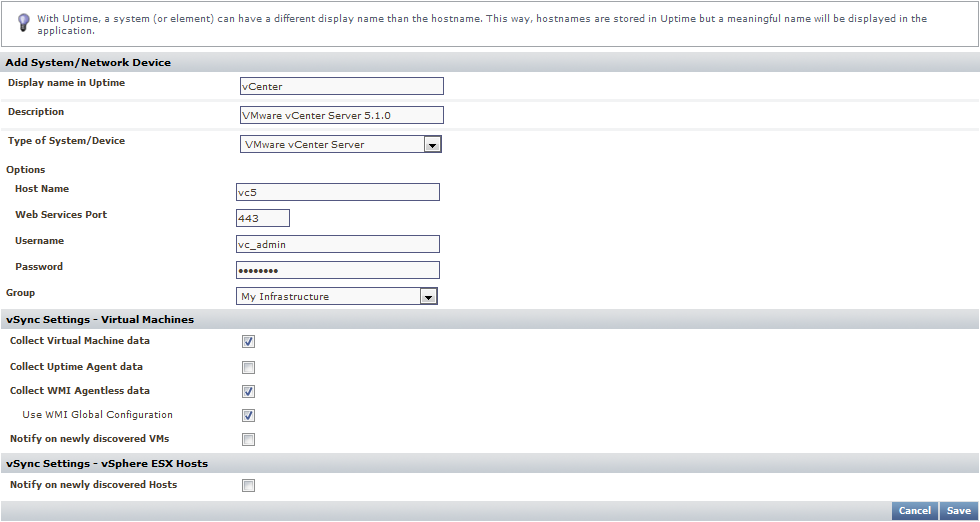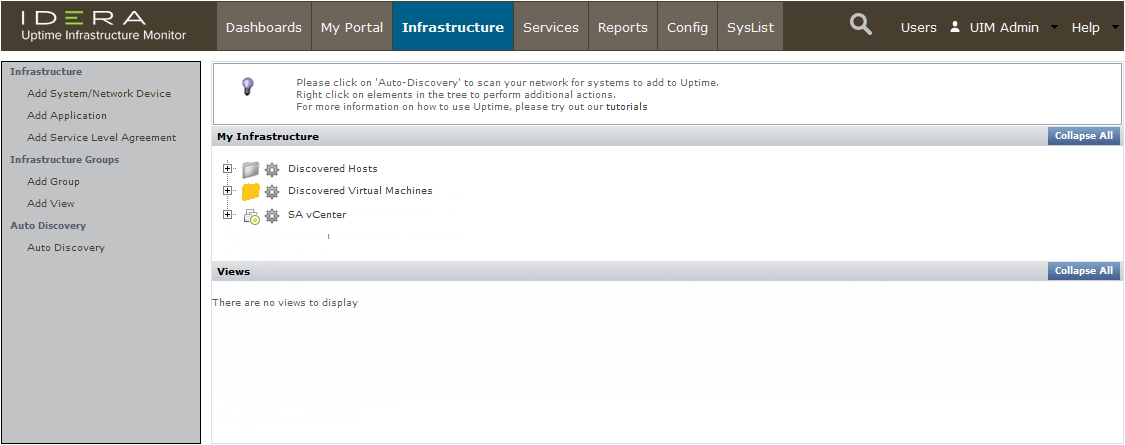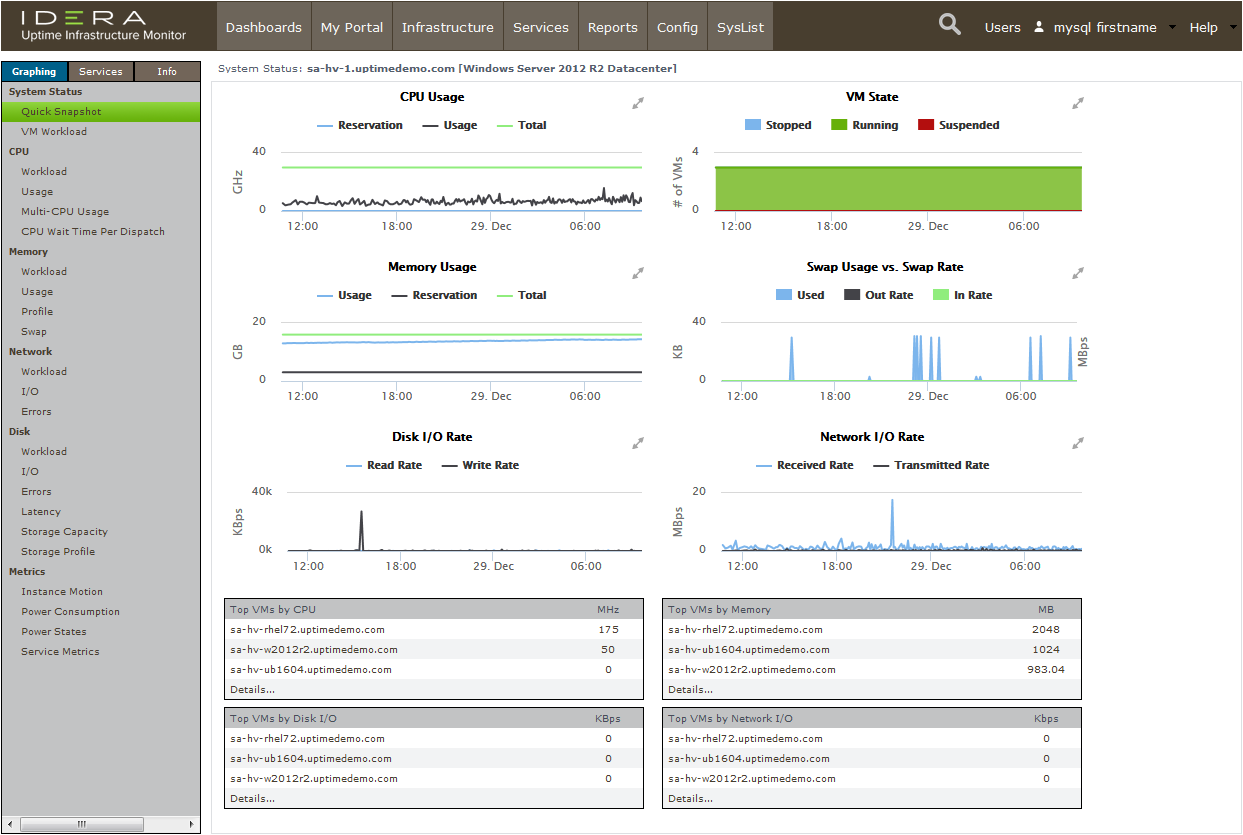...
| Module | Description | Time required |
|---|---|---|
| Add Your vCenter Server | Use Auto Discovery to import a VMware vCenter Server and its inventory of ESX servers and VMs. | 1 slice |
| Validation Step 1: Explore the Monitored Inventory | Understand how up.time Uptime Infrastructure Monitor organizes an imported and synchronized vCenter Server inventory. | 1 slice |
| Validation Step 2: View the vCenter Server Inventory | Understand how up.time Uptime Infrastructure Monitor allows you to focus on the parts of the vCenter Server that you actually want to monitor. | 1 slice |
| Validation Step 3: View Metrics for the vCenter Server and a VM | View metrics available on a summary page for a vCenter server, as well as a VM. | ½ slice |
Add Your vCenter Server
- In the up.time Uptime Infrastructure Monitor Web interface, begin by clicking My Infrastructure.
- Begin adding your VMware vCenter Server as an up.time Uptime Infrastructure Monitor Element. In the My Infrastructure view, click Add System/Network Device.
- In the Add System window, select VMware vCenter Server from the Type of System/Device drop-down. This reveals configuration fields specific to this type of monitored Element.
- Complete the fields similar to those below:
- The Display Name is used throughout the up.time Uptime Infrastructure Monitor interface, as well as reports.
- The Description can contain any extra information such as the version number or IP address.
- The Options fields tell up.time Uptime Infrastructure Monitor how to find and access your vCenter Server.
- The Group fields allow you to sort virtual machines and ESX host machines.
- You can leave the vSync Settings options at their defaults.
Note title Stick to the Basics By default, the Collect up.time Uptime Agent data and check box is clear. For this exercise, clear the Collect WMI Agentless data check boxes are clearbox as well. This means the metrics up.time Uptime Infrastructure Monitor retrieves for each monitored VM is what the vCenter Server itself collects and provides to up.timeUptime Infrastructure Monitor. For these "basic VMs," , their metrics are a subset of what can be collected from the guest operating system using the up.time agent Uptime Infrastructure Monitor Agent or using WMI. For simplicity in this guide, we will work with a "basic" vCenter Server inventory. You can learn more about agent- and WMI-based data collection in the next module, where you are adding physical servers.
- Click Save. up.time will search Uptime Infrastructure Monitor searches for your vCenter Server and import its inventory of ESX hosts and VMs as up.time Uptime Infrastructure Monitor Elements. This can take a minute or more, depending on how large your vCenter inventory is.
- up.time will inform Uptime Infrastructure Monitor informs you when the vCenter Server has been is added:
Click Done to close the Add System window.
...
After adding the vCenter Server and closing the Add System window in the previous section, the main UI window is displaying the My Infrastructure view:
If you look at your up.time Uptime Infrastructure Monitor inventory, you can see that part of the vCenter Server import process included the automatic creation of two top-level Element Groups (which are folders and subfolders used to organize up.time Uptime Infrastructure Monitor Elements): Discovered Hosts and Discovered Virtual Machines. These Element Groups respectively include the ESX hosts and virtual machines managed by the vCenter Server, and these contents can be further rearranged in up.timeUptime Infrastructure Monitor, for example, by platform or server function.
Alongside this pair of Infrastructure Groups, the vCenter Server itself appears as a top-level Element in My Infrastructure. It includes the hierarchy of objects that comprise the vCenter Server inventory. Click the + icon beside your vCenter Server to expand its view.
...
In the above example, the datacenter's cluster of ESX hosts is organized into two resource pools, along with their component virtual machines. Hosts and virtual machines can be moved elsewhere in My Infrastructure, but the hierarchy remains intact as a reflection of the vCenter Server:
| Note | ||
|---|---|---|
| ||
Depending on the size of your vCenter Server inventory, importing one could exceed your up.time Uptime Infrastructure Monitor license. If this were to happen, you might see the following:
In this scenario, you need not worry. up.time Uptime Infrastructure Monitor has in fact imported these; it is simply ignoring them. We will learn more about this in the next section. |
...
This validation step can be particularly enlightening if your vCenter Server import exceeded your license, and resulted in automatic exclusion of ESX hosts and VMs being automatically excluded from the monitored inventory in up.timeUptime Infrastructure Monitor.
- While in the My Infrastructure view, click the vCenter Server's gear icon, then in the pop-up menu, click View.
In the left menu, the Info tab is active. Click Inventory Detail.
This displays a list of all of your vCenter Server's inventory, grouped hierarchically. It is divided into two main groups: Elements that are monitored by up.timeUptime Infrastructure Monitor, and Elements that are currently ignored. Initially, during the vCenter Server import, hosts and VMs that were imported after the up.time Uptime Infrastructure Monitor license was exceeded were placed in the Ignored Elements section. You can use this Inventory Detail view to ignore monitored Elements, and begin monitoring currently ignored Elements.Info title Pro Tip You can also use this Inventory Detail view to Enable Monitoring for a vCenter Server Element. This can be done when an up.time agent Uptime Infrastructure Monitor Agent is installed on a VM, allowing up.time Uptime Infrastructure Monitor to collect metrics that are more detailed than what is provided by the vCenter Server.
Validation Step 3 > View Metrics for the vCenter Server and a VM
- Click My Infrastructure.
- Click the vCenter Server's gear icon, then in the pop-up menu, click Graph Performance. Whenever you take this action with an Element, you are taken to its Quick Snapshot.
Whenever you graph the performance of an Element from the My Infrastructure view, its Quick Snapshot is displayed. What exactly is shown depends on the type of Element, which we will see throughout this part of the Getting Started Guide. In this case, the vCenter Server's Quick Snapshot shows datacenter-level information that is directly pulled from the vCenter Server metrics:
You can incorporate these basic metrics into your up.time Uptime Infrastructure Monitor monitoring plans (such as alerts or reporting). It's more likely, however, that your interest will be is with the virtual machines that are a part of the vCenter Server inventory. - Click My Infrastructure to return to the main inventory view.
- Expand the Discovered Virtual Machines Infrastructure Group, and click the gear icon for any of the VMs. In the pop-up menu, again, click Graph Performance to display that Element's Quick Snapshot. This displays metrics for the VM that have been are pulled from the vCenter Server's metrics:
As with the vCenter Server Element's metrics, you can incorporate these into your alerts and reports. However, this "basic VM" view allows you to work only with what the vCenter Server provides; there may be cases where you want to add a little extra "up.time Uptime Infrastructure Monitor power," and install an up.time Uptime Infrastructure Monitor agent on the VM. This is something you will learn a bit more about in the next module.
| Note | ||
|---|---|---|
| ||
In this module, if the inventory imported from vCenter Server exceeds open slots in your license, some of the inventory will have been is ignored, and you will have no space left to add Elements to your monitored inventory. In the next two tracks In this Getting Started Guide, you will be are adding servers and network devices. If you plan on following either or both of these tracks, you need to anticipate the number of servers and network devices you will add. To follow the server track, you'll need at least 2; to follow the network device track, you'll need at least 1. The easiest way to free up space is to manually ignore VMs; each VM you ignore opens a license spot for a new Element. Return to the Inventory Detail view for the vCenter (My Infrastructure > gear icon > View > Inventory Detail). Select VMs, ESX hosts, or even an entire cluster, then click Add Selected Elements to Ignore. That number of spots will be The spots are freed up in your license, which you can verify by clicking Config > License Info. Alternatively, you can also contact uptime software Customer Support your Uptime Sales representative at [email protected] to look into increasing the size of your license. |
...
| Section | ||||||||||
|---|---|---|---|---|---|---|---|---|---|---|
| ||||||||||
|





